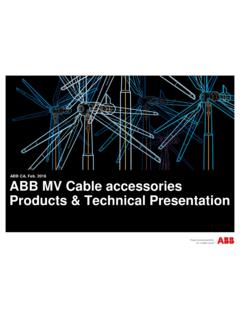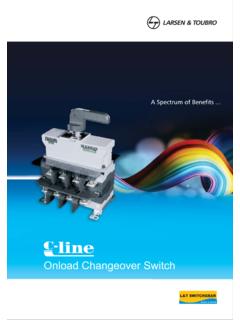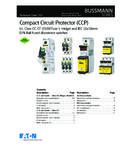Transcription of Coordination tables - ABB Ltd
1 Coordination tables 1 SDC007004D0204. Coordination tables 1 SDC007004D0204 - 12/2004. Printed in Italy Due to possible developments of standards as well as of materials, the characteristics and dimensions specified in the present Tipografia catalogue may only be considered binding after confirmation by ABB SACE. ABB SACE An ABB Group company Breakers Via Baioni, 35. 24123 Bergamo, Italy Tel.: +39 - Telefax: +39 Coordination tables Index Introduction .. I. Back-up ..1/1. Discrimination ..2/1. Motor protection ..3/1. Switch-disconnectors ..4/1. ABB SACE. Coordination tables Introduction Discrimination and back-up .. II. Choosing the type of Coordination for protection of a low voltage installation .. II. Types of Coordination .. III. General notes on switching and protection of VIII. Electromechanical starter .. VIII. Starting methods .. IX. Switch-disconnectors .. XII. ABB SACE I. Coordination tables Discrimination and back-up This collection of selectivity and back-up tables for ABB circuit-breakers has been studied to help select the appropriate circuit-breaker, fulfilling the specific selectivity and back-up requirements according to the different types of installation.
2 The tables are divided on the basis of the type of intervention (back-up or selective protection), and are grouped according to types of circuit-breakers (air, moulded-case, and miniature), covering all the possible combinations of ABB circuit-breakers. The technical data, updated to the latest series of miniature, moulded-case and air circuit breakers on the market, make this publication a comprehensive and simple tool: once again, ABB SACE makes its consolidated experience in the Low Voltage sector available to professionals. Choosing the type of Coordination for protection of a low voltage installation Problems and requirements for coordinating protection devices Selection of the system for protecting an electric installation is of paramount importance both to ensure correct economic and functional operation of the whole installation and to reduce any problems caused by anomalous operating conditions and actual faults to a minimum. This analysis deals with Coordination between the different devices dedicated to protection of zones and specific components in order to: guarantee safety for people and the installation at all times.
3 Identify and rapidly exclude only the zone affected by a given problem, instead of taking indiscriminate action thereby reducing the energy available in areas unaffected by the fault;. reduce the effects of a fault on other sound parts of the installation (voltage drops, loss of stability in rotating machines);. reduce the stress on components and damage in the zone involved;. ensure service continuity with good quality power supply voltage;. guarantee adequate backup in the event of any malfunction of the protection device responsible for opening the circuit;. provide maintenance personnel and the management system with the information needed to restore the service as rapidly as possible and with minimal disturbance to the rest of the network;. achieve a valid compromise between reliability, simplicity and cost effectiveness. To be more precise, a valid protection system must be able to: understand what and where an event has occurred, discriminating between situations that are anomalous but tolerable and genuine faults within a given zone of influence, avoiding unwarranted trips which lead to unjustified stoppage of a sound part of the installation.
4 Act as rapidly as possible to limit damage (destruction, accelerated ageing, etc.), safeguarding continuity and stability of the power supply. The solutions stem from a compromise between the following two opposing needs - precise identification of the fault and rapid intervention - and are defined according to which requirement takes priority. For instance, when it is more important to avoid unnecessary tripping, it is generally preferable to have an indirect protection system based on interlocks and data transmission between different devices which measure the electrical values locally, whereas for prompt response and limitation of the destructive effect of short-circuits, a direct-acting system with releases integrated in the devices is needed. Generally speaking, in low voltage systems for primary and secondary distribution, the latter solution is preferable. II ABB SACE. Coordination tables Discrimination and back-up Restricting the field to an analysis of the problem of how to harmonize the action of the protection devices in the event of overcurrents (overloads and short-circuits) - a problem covering 90% of the Coordination requirements of protection devices in radial low voltage installations - it is important to remember that: overcurrent trip selectivity means Coordination of the operating characteristics of two or more overcurrent protection devices so that, on occurrence of overcurrents within established limits, the device supposed to operate within these limits intervenes, whereas the others do not 1.
5 Total discrimination means overcurrent selectivity so that when there are two overcurrent protection devices in series, the protection device on the load side provides protection without tripping the other protection device 2;. partial discrimination means overcurrent selectivity so that when there are two overcurrent protection devices in series, the protection device on the load side provides protection up to a given overcurrent limit without tripping the other device 3. This overcurrent threshold is called the selectivity limit current Is 4;. back-up protection means Coordination for protection against overcurrents of two protection devices in series, where the protection device generally (but not necessarily). situated on the supply side provides overcurrent protection with or without the aid of the other protection device and avoids excessive stress on the latter 5. The current value above which protection is ensured is called the switching current IB 6. Types of Coordination Influence of the electrical parameters of the installation (rated current and short- circuit current).
6 If the analysis is restricted to the behaviour of the protection devices with tripping based on overcurrent releases, the strategy used to coordinate the protection devices mainly depends on the rated current (In) and short-circuit current (Ik) values in the part of installation concerned. Generally speaking, the following types of Coordination can be classified: current type selectivity;. time type selectivity;. zone selectivity;. energy selectivity;. back-up. Now let us examine these various solutions in detail. 1. IEC 60947-1 Standard, def. 2. IEC 60947-2 Standard, def. 3. IEC 60947-2 Standard, def. 4. IEC 60947-2 Standard, def. 5. IEC 60947-1 Standard, def. 6. IEC 60947-1 Standard, def. and IEC 60947-1 Standard, def. ABB SACE III. Coordination tables Discrimination and back-up Current type selectivity This type of discrimination is based on the observation that the closer the fault is to the power supply of the installation, the higher the short-circuit current will be. We can therefore pinpoint the zone where the fault has occurred can therefore be discriminated simply by setting the protection devices to a limit value so that this does not generate unwarranted trips due to faults in the zone of influence of the protection device immediately to the load side (where the fault current must be lower than the current threshold set on the protection device on the supply side).
7 Total discrimination can normally only be obtained in specific cases where the fault current is not very high or where a component with high impedance is placed between the two protection devices ( a transformer, a very long cable, or a cable with reduced cross-section, etc.) giving rise to a great difference between the short-circuit current values. This type of Coordination is therefore mainly used in end distribution (with low rated current and short-circuit current values and high impedance of the connection cables). The device time-current trip curves are generally used for the study. This solution is intrinsically rapid (instantaneous), easy to implement and inexpensive. On the other hand: the selectivity limit current is normally low, so discrimination is often only partial;. the threshold setting of the overcurrent protection devices rapidly exceeds the values consistent with safety requirements, becoming incompatible with the need to reduce damage caused by short-circuits.
8 It becomes impossible to provide redundant protection devices which can guarantee elimination of the fault in the event of any of the protection devices failing to function. Time type selectivity This type of discrimination is an evolution of the previous one. Using this type of Coordination , in order to define the trip threshold, the current value measured is associated with the duration of the phenomenon: a given current value will trip the protection devices after an established time delay, which is such as to allow any protection devices situated closer to the fault to trip, excluding the zone where the fault occurred. The setting strategy is therefore to progressively increase the current thresholds and the trip time delays the closer one is to the power supply source (the setting level correlates directly with the hierarchical level). The steps between the time delays set on protection devices in series must take into account the sum of the times for detecting and eliminating the fault and the overshoot time of the supply side device (the time interval during which the protection device can trip even if the phenomenon has already ended).
9 As in the case of current type selectivity, the study is carried out by comparing the time-current protection device trip curves. This type of Coordination is generally: easy to study and implement, and inexpensive with regard to the protection system;. it allows even high limit discrimination levels to be obtained, depending on the shorttime withstand current of the supply side device;. it allows redundant protection functions and can send valid information to the control system;. but: the trip times and energy levels let through by the protection devices, especially those close to the sources, are high, with obvious problems regarding safety and damage to the components (often oversized) even in zones unaffected by the fault;. it only allows use of current-limiting circuit-breakers at levels hierarchically lower down the chain. The other circuit-breakers must be capable of withstanding the thermal and electro-dynamic stresses related to the passage of the fault current for the intentional IV ABB SACE.
10 Coordination tables Discrimination and back-up time delay. Selective circuit-breakers, often of the open type, must be used for the various levels (category B circuit-breakers according to the IEC 60947-2 Standard) to guarantee a sufficiently high short-time withstand current;. the duration of the disturbance induced by the short-circuit current on the power supply voltages in the zones unaffected by the fault can pose problems with electromechanical (voltage below the electromagnetic release value) and electronic devices;. the number of discrimination levels is limited by the maximum time which can be withstood by the electrical system without loss of stability. Zone (or logical) selectivity This type of Coordination is a further evolution of time Coordination and can be direct or indirect. Generally speaking, it is implemented by means of a dialogue between currentmeasuring devices which, when they detect that the setting threshold has been exceeded, enable correct identification and power supply disconnection of just the zone affected by the fault.











